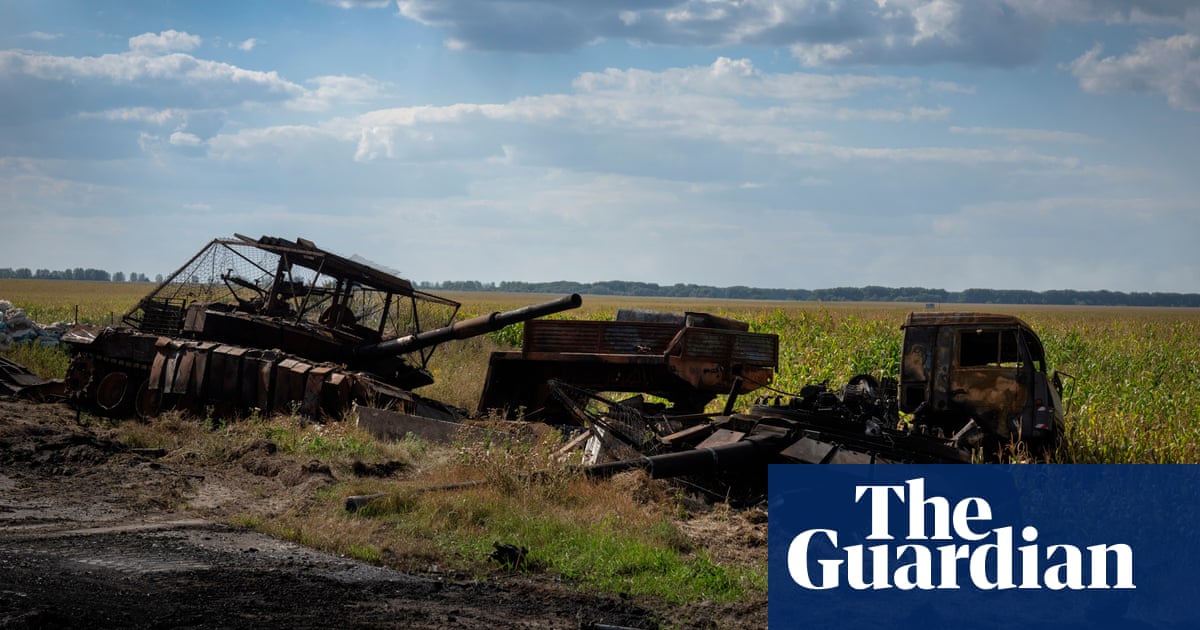Ukraine has captured more than 150 Russian prisoners of war on some days in the cross-border military operation that a key civilian official said was the first of “several stages” in taking the fight to Moscow.
Oleksii Drozdenko, the head of the military administration in the Ukrainian city of Sumy, said the attack had fared better than expected and there had been only 15 casualties needing hospital treatment on the first day.
“Sometimes there are more than 100 or 150 prisoners of war a day,” Drozdenko said. Many of the Russian troops who have been guarding the border are young conscripts. “They do not want to fight us,” he added.
Several videos have circulated of Ukrainians capturing prisoners of war, including at the border in the first hours of the incursion on Tuesday 6 August. Ukraine’s president, Volodymyr Zelenskiy, has said Kyiv is increasing its “exchange fund” to swap for PoWs held by Russia.
Sumy is the Ukrainian city closest to the incursion and Drozdenko said he had been closely involved in the operation’s planning but had been sworn to secrecy, zipping his lips in a gesture to describe the importance of operational security before the surprise attack.
Other local civilian leaders, notably the Sumy region’s governor, Volodymyr Artyukh, have said they were not warned in advance, suggesting Drozdenko was in a trusted circle.
The city official, a Zelenskiy appointee who is the city’s de facto mayor after the previous incumbent was arrested and charged for allegedly receiving a bribe last autumn, said he could not say too much about the preparations for the incursion a fortnight ago because there was more to come.
“We see only part of this operation, in the future we will see several stages,” Drozdenko said, characterising the incursion as “not like previous raids” from Ukraine into Belgorod oblast to the east, which were largely led by anti-Kremlin Russian groups.
Though Drozdenko would not offer any more information, there are signs that Ukraine has introduced a new tactic to try to gain more Russian territory. On Sunday morning Ukraine’s air force released a video of a hole being blown in a bridge at Zvannoe, over the Seym River inside Kursk province.
A couple of days earlier another bridge over the Seym had been severed after a Ukrainian air attack, north of the village of Glushkovo, which is near the frontline of the incursion and subject to a civilian evacuation order by Russian authorities.
Though Ukraine has not spelled out its intentions, knocking out the three bridges over the Seym at Glushkovo, Zvannoe and Karyzh would complicate Russian reinforcement of a pocket of land to the west of the current incursion area and improve Ukraine’s prospects of seizing the land if its progress continues.
At the end of last week, Sumy and other neighbouring regions organised a humanitarian transport of food and medicine to Russian civilians in the occupied area, including from “our own food stores”, Drozdenko said. No Russian civilians had fled across the border to become refugees in Ukraine, he said.
Part of Drozdenko’s role was to ensure hospitals in Sumy were ready to receive casualties once the incursion started. “There is an unexpectedly low amount of wounded coming from this operation into the hospitals,” the official said.
after newsletter promotion
“On the first day of the operation, there were only 15 casualties. Sixty, seventy per cent of them were very light, caused by bomb damage, shrapnel,” he added, reflecting the fact that the cross-border attack was a complete surprise to the Kremlin, which believed Ukraine would fight to defend its own territory.
At the end of last week, civilians in Sumy were asked to donate O-negative blood, suitable for emergency transfusions for any blood type. The need was met “in one hour”, the official said, which “confirms that our people support this operation”.
Sumy city, a quiet provincial capital in north-east Ukraine with a population of about 250,000, had not been involved in the fighting since the desperate early days of the war when it was surrounded and defended by a civilian militia, of which Drozdenko was part.
But the incursion has brought the war back to Sumy and the border areas to the north, with renewed air, missile and artillery strikes. “When we speak about seven months of 2024, January to July, there were approximately 400 strikes to border areas. But last week we had 200 strikes in only one week,” the official said.
Several thousand have fled the frontline regions, which have been subject to a mandatory evacuation up to 10km (6.2 miles) from the border in affected areas. Drozdenko said those fleeing would try to arrange their own accommodation or be housed in hostels in the city.
Sumy has been protected by air defence, with interceptions and launches heard and seen from the city centre over the last week. On Saturday morning one ballistic missile got through and landed in a street, damaging about 15 civilian cars and wounding two people, although not seriously.
People in Sumy were resilient despite the latest bombing, Drozdenko said, because the city had fought off the initial Russian invasion in March 2022, at a time when the regular army was 60 miles away.
Highlighting his own experience, he said: “Back then I was not feeling that optimistic. We took part in street fighting. I was almost nearly killed twice. It was very scary being shot at by a BTR [Russian armoured personnel carrier]. Now I’m not scared of anything.”
